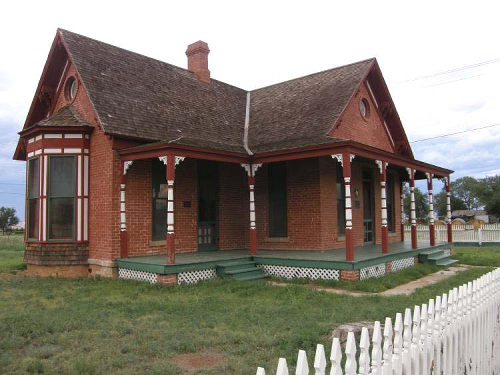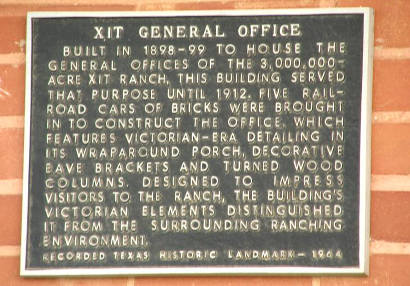|
The
XIT Ranch was different from the traditional Western ranch of the
time. The land was the same, the cattle and cowboys were alike and
much of the ranch work was similar to the regular old-time ranch work.
However, a close study shows it was in the organizational structure
and financial planning where the largest differences appeared.
For example, where the traditional ranch had a boss or foreman the
XIT had a president, board of directors, financial officers, bookkeeper,
general manager, range bosses, wagon bosses, straw-bosses as well
as cowboys, cooks and wranglers. At its peak the XIT employed 150
men.
A traditional ranch owner was usually a weathered, bowlegged cowboy-type
who had grown up with cattle and horses. Most of the XIT owners and
officers lived in Chicago and knew little about cattle except that
steaks tasted mighty good on a platter. |
 |
 |
The
XIT was established at a time when traditional ranches preferred the
old open-range concept with huge pastures and little fencing. In contrast,
the XIT divided the vast 3,050,000 acres into seven divisions under
the supervision of range and wagon bosses and used 6,000 miles of
barbed
wire in fencing the outside boundaries and divisions. The drilling
of windmills
where needed made the division of the dry ranges possible.
Most ranches of the time were poorly organized, usually depending
on borrowed money for operation. Many were rich in good times and
broke during the bad. The XIT brought proven business methods, planning
know-how and exact bookkeeping, all of which were backed up by millions
of dollars available for operating expenses.
The poor overworked average cowboy was expected to do all the work
on most ranches. The XIT hired fencing crews, experienced windmill
repairmen, well-drilling companies, carpenters for building and independent
freighters to keep the ranch warehouses well-stocked with supplies.
Where the typical rancher resisted the oncoming tide of settlers making
every effort to keep them from settling permanently, the XIT laid
long-range plans to sell all land suitable for farming whenever the
price per acre reached the proper level for profit.
The XIT "Poor Farm" as the cowboys called it, located some seven miles
southwest of Channing,
was actually a ranch-operated experimental farm using good equipment,
experienced farmers and the latest in Department of Agriculture advice.
Their records became proof to the new settlers that the land was good
farmland and was capable of raising any number of dry-land grains
along with the regular mix of livestock. These early experiments set
the stage for today's "bread-basket-of-the-world" farming expertise
famous throughout the Great Plains.
A little pencil work reveals the original price of $1 per acre price,
providing $3 million to build the Texas State Capitol, eventually
sold for $5 to $20 dollars or more per acre. These profits, plus the
profit from operating the successful enterprise for many years, provided
the owners with millions of dollars profit for their work and expertise.
In retrospect, the entire XIT experience might be considered the end
of the old traditional Western ranch and the beginning of the new-era
ranching. Yes, there is no doubt the XIT Ranch was different.
© Delbert Trew
"It's All Trew"
August 12, 2008 Column
E-mail: trewblue@centramedia.net. |
|
|

 Gulf
Coast
Gulf
Coast East
Texas
East
Texas Central
North
Central
North Central
South
Central
South Panhandle
Panhandle South
Texas
South
Texas Hill
Country
Hill
Country West
Texas
West
Texas Ghost
Towns
Ghost
Towns COUNTIES
COUNTIES